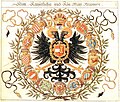Ficheru:Wappen röm.kaiser.JPG

Tamañu d'esta previsualización: 707 × 599 pixels. Otres resoluciones: 283 × 240 pixels | 566 × 480 pixels | 920 × 780 pixels.
Ficheru orixinal (920 × 780 píxels, tamañu de ficheru: 279 kB, triba MIME: image/jpeg)
Historial del ficheru
Calca nuna fecha/hora pa ver el ficheru como taba daquella.
| Data/Hora | Miniatura | Dimensiones | Usuariu | Comentariu | |
|---|---|---|---|---|---|
| actual | 21:18 14 och 2005 |  | 920 × 780 (279 kB) | Finanzer | * Technisch nachbearbeitet von wolpertinger |
| 20:38 31 ago 2005 |  | 998 × 846 (171 kB) | Fb78 | '''Description''' Wappen der Kaiser des Heiligen Römischen Reiches Deutscher Nation '''Source:''' Wappenbuch von Johann Siebmacher, 1605 Uploaded by de:Benutzer:Hansele |
Usu del ficheru
Les páxines siguientes usen esti ficheru:
Usu global del ficheru
Estes otres wikis usen esti ficheru:
- Usu en an.wikipedia.org
- Usu en ar.wikipedia.org
- ليوبولد الثاني (إمبراطور روماني مقدس)
- هابسبورغ
- فرديناند الأول (إمبراطور روماني مقدس)
- فيتلسباخ
- بالاتينات الانتخابية
- ألكسندر براون
- دوقية براونشفايغ لونيبورغ
- اتحاد شمالكالدي
- اجتماع شباير الثاني
- دوقية لورين
- أرنولف الكارينثي
- إمارة بايرويت
- إمارة أنسباخ
- لاندغريفية هسن دارمشتات
- ساكس فايمار
- دوقية ساكسونيا هيلدبورغهاوزن
- دوقية ساكسونيا غوتا ألتنبورغ
- دوقية ساكسونيا كوبورغ زالفلد
- دوقية أولدنبورغ
- انتخابية هسن
- لورين المنخفضة
- الأقاليم السبعة عشر
- خيلدرز
- بوابة:الإمبراطورية النمساوية/مقالة مختارة
- بوابة:الإمبراطورية النمساوية/مقالة مختارة/2
- بوابة:الإمبراطورية النمساوية
- بوابة:الإمبراطورية النمساوية/مقالة مختارة/أرشيف
- ليوبولد موتسارت
- موريتس بالتازار بوركهاوزن
- كونتية أرتوا
- الأراضي المنخفضة النمساوية
- فريدريش ألبرخت أنطون ماير
- يوري فيغا
- غابرييل غروبر
- ألبرت الرابع، دوق النمسا
- الأرشيدوقة ماريا آنا من النمسا (1610-1665)
- فيلهلم فريديمان باخ
- البرلمان الامبراطوري
- ليوبولد الرابع دوق النمسا
- يوهان كاسبار فون ستاديون
- معاهدة جيرستنجن
- سلام نيكولسبورغ
- معاهدة السلام في جميع أنحاء العالم المسيحي
- دوقية بوهيميا
- رودولف الثاني كونت هابسبورغ
- ألبرخت الرابع كونت هابسبورغ
- قالب:بذرة أعلام الإمبراطورية الرومانية المقدسة
- قالب:بذرة طبيب روماني مقدس
- قالب:بذرة كيميائي روماني مقدس
Ver más usos globales d'esti ficheru.
